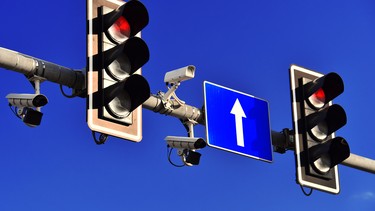Technology
Study Reveals Automatic Braking Reduces Crashes at Red Lights

Research conducted by the Insurance Institute for Highway Safety (IIHS) confirms that red-light cameras effectively prevent mid-intersection accidents. The study highlights that while these cameras are successful in reducing serious crashes, they have inadvertently led to an increase in less severe rear-end collisions. This phenomenon occurs as drivers, eager to avoid penalties, often brake suddenly when approaching intersections equipped with these cameras.
The IIHS states that the presence of red-light cameras is linked to a notable rise in abrupt stops at intersections, which in turn contributes to a higher frequency of rear-end crashes. According to the study, these incidents are primarily caused by drivers who are not prepared for the sudden braking of vehicles in front of them. This unintended consequence emphasizes the complexity of traffic safety measures and their varied impacts on driver behavior.
Understanding the Impact of Red-light Cameras
The data from the IIHS indicates that the implementation of red-light cameras has resulted in a significant reduction in the number of severe accidents at intersections. Specifically, studies show that cities deploying these cameras have reported a drop in fatal and serious injury crashes. However, the IIHS also points out that the increase in rear-end collisions could complicate the overall assessment of red-light camera effectiveness.
Motorists are not only reacting to the cameras but also adjusting their driving patterns. The anxiety of potentially receiving a fine can lead to abrupt stops, creating a ripple effect in traffic flow. The IIHS notes that these sudden stops are particularly problematic during peak traffic hours when road conditions are already challenging.
Balancing Safety and Driver Behavior
As cities continue to adopt red-light camera systems in an effort to enhance road safety, it is crucial to understand the broader implications of these technologies. The challenge lies in balancing the benefits of reduced serious accidents with the risk of increased minor collisions.
Authorities and traffic safety advocates are urged to consider these findings as they implement and evaluate traffic enforcement measures. Enhanced public awareness campaigns could help educate motorists on safe driving practices in the vicinity of red-light cameras, potentially mitigating the likelihood of rear-end crashes.
In summary, while red-light cameras play a pivotal role in promoting road safety, their introduction requires a nuanced approach that takes into account the broader implications for driver behavior and road safety dynamics.
-

 Politics4 weeks ago
Politics4 weeks agoSecwepemc First Nation Seeks Aboriginal Title Over Kamloops Area
-

 World5 months ago
World5 months agoScientists Unearth Ancient Antarctic Ice to Unlock Climate Secrets
-

 Entertainment5 months ago
Entertainment5 months agoTrump and McCormick to Announce $70 Billion Energy Investments
-

 Science5 months ago
Science5 months agoFour Astronauts Return to Earth After International Space Station Mission
-

 Lifestyle5 months ago
Lifestyle5 months agoTransLink Launches Food Truck Program to Boost Revenue in Vancouver
-

 Technology3 months ago
Technology3 months agoApple Notes Enhances Functionality with Markdown Support in macOS 26
-

 Lifestyle3 months ago
Lifestyle3 months agoManitoba’s Burger Champion Shines Again Amid Dining Innovations
-

 Top Stories2 months ago
Top Stories2 months agoUrgent Update: Fatal Crash on Highway 99 Claims Life of Pitt Meadows Man
-

 Politics4 months ago
Politics4 months agoUkrainian Tennis Star Elina Svitolina Faces Death Threats Online
-

 Sports5 months ago
Sports5 months agoSearch Underway for Missing Hunter Amid Hokkaido Bear Emergency
-

 Politics5 months ago
Politics5 months agoCarney Engages First Nations Leaders at Development Law Summit
-

 Technology5 months ago
Technology5 months agoFrosthaven Launches Early Access on July 31, 2025












